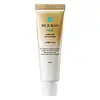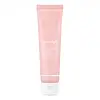What's inside
What's inside
 Key Ingredients
Key Ingredients

 Benefits
Benefits

 Concerns
Concerns

 Ingredients Side-by-side
Ingredients Side-by-side

Water
Skin ConditioningGlycerin
HumectantButylene Glycol
HumectantMethyl Hydrogenated Rosinate
PerfumingDipropylene Glycol
HumectantDistarch Phosphate
AbsorbentDicaprylyl Carbonate
EmollientCetearyl Alcohol
EmollientNiacinamide
SmoothingPentylene Glycol
Skin ConditioningPolyglyceryl-3 Methylglucose Distearate
Emulsifying1,2-Hexanediol
Skin ConditioningChlorella Vulgaris Extract
Skin ConditioningRh-Rice Extract
Skin ConditioningActinidia Chinensis Fruit Extract
EmollientAlthaea Rosea Flower Extract
Skin ConditioningGlycine Soja Extract
Skin ConditioningSalmon Egg Extract
Sodium Hyaluronate
HumectantBis-Diglyceryl Polyacyladipate-2
EmollientOctyldodecanol
EmollientHydroxyethyl Acrylate/Sodium Acryloyldimethyl Taurate Copolymer
Emulsion StabilisingC12-15 Alkyl Benzoate
AntimicrobialDimethicone
EmollientHydroxyacetophenone
AntioxidantGlucose
HumectantHydrolyzed Dna
Skin ConditioningAcrylates/C10-30 Alkyl Acrylate Crosspolymer
Emulsion StabilisingTromethamine
BufferingFructooligosaccharides
HumectantFructose
HumectantPanthenol
Skin ConditioningCetearyl Glucoside
EmulsifyingAdenosine
Skin ConditioningSodium Phytate
Tocopherol
AntioxidantEthylhexylglycerin
Skin ConditioningTrehalose
HumectantUrea
BufferingGlyceryl Polyacrylate
Serine
MaskingCaprylyl Glycol
EmollientAlgin
MaskingPullulan
Disodium Phosphate
BufferingPotassium Phosphate
BufferingWater, Glycerin, Butylene Glycol, Methyl Hydrogenated Rosinate, Dipropylene Glycol, Distarch Phosphate, Dicaprylyl Carbonate, Cetearyl Alcohol, Niacinamide, Pentylene Glycol, Polyglyceryl-3 Methylglucose Distearate, 1,2-Hexanediol, Chlorella Vulgaris Extract, Rh-Rice Extract, Actinidia Chinensis Fruit Extract, Althaea Rosea Flower Extract, Glycine Soja Extract, Salmon Egg Extract, Sodium Hyaluronate, Bis-Diglyceryl Polyacyladipate-2, Octyldodecanol, Hydroxyethyl Acrylate/Sodium Acryloyldimethyl Taurate Copolymer, C12-15 Alkyl Benzoate, Dimethicone, Hydroxyacetophenone, Glucose, Hydrolyzed Dna, Acrylates/C10-30 Alkyl Acrylate Crosspolymer, Tromethamine, Fructooligosaccharides, Fructose, Panthenol, Cetearyl Glucoside, Adenosine, Sodium Phytate, Tocopherol, Ethylhexylglycerin, Trehalose, Urea, Glyceryl Polyacrylate, Serine, Caprylyl Glycol, Algin, Pullulan, Disodium Phosphate, Potassium Phosphate
Water
Skin ConditioningDisodium EDTA
Betaine
HumectantNiacinamide
SmoothingAdenosine
Skin ConditioningCitric Acid
BufferingPanthenol
Skin ConditioningGlycereth-26
HumectantGlycerin
HumectantGlyceryl Acrylate/Acrylic Acid Copolymer
HumectantButylene Glycol
HumectantHydroxyethyl Acrylate/Sodium Acryloyldimethyl Taurate Copolymer
Emulsion StabilisingSorbitan Isostearate
EmulsifyingCetearyl Olivate
Sorbitan Olivate
EmulsifyingCaprylic/Capric Triglyceride
MaskingLimnanthes Alba Seed Oil
Skin ConditioningHydrogenated Polydecene
EmollientIsononyl Isononanoate
EmollientHydrogenated Lecithin
EmulsifyingCetearyl Alcohol
EmollientStearic Acid
CleansingCeramide EOP
Skin ConditioningCeramide Ns
Skin ConditioningCeramide NP
Skin ConditioningCeramide As
Skin ConditioningCeramide AP
Skin ConditioningPhytosphingosine
Skin ConditioningCholesterol
EmollientCyclopentasiloxane
EmollientSodium Dna
Skin ConditioningEthylhexyl Olivate
Skin ConditioningSodium Acrylates Copolymer
Polyglyceryl-4 Oleate
Emulsifying1,2-Hexanediol
Skin ConditioningCopper Tripeptide-1
Skin ConditioningAcetyl Hexapeptide-8
HumectantPalmitoyl Pentapeptide-4
Skin ConditioningPalmitoyl Tripeptide-1
Skin ConditioningPalmitoyl Tetrapeptide-7
Skin ConditioningSodium Hyaluronate
HumectantHydroxypropyltrimonium Hyaluronate
Sodium Acetylated Hyaluronate
HumectantHydrolyzed Hyaluronic Acid
HumectantHyaluronic Acid
HumectantSodium Hyaluronate Crosspolymer
HumectantHydrolyzed Sodium Hyaluronate
Skin ConditioningPotassium Hyaluronate
Skin ConditioningFucus Vesiculosus Extract
EmollientPrunella Vulgaris Extract
AntioxidantMomordica Charantia Fruit Extract
Skin ConditioningHibiscus Esculentus Fruit Extract
Skin ConditioningMorinda Citrifolia Fruit Extract
Skin ConditioningCentella Asiatica Leaf Extract
Skin ConditioningEthylhexylglycerin
Skin ConditioningParfum
MaskingCyanocobalamin
Skin ConditioningSodium Polyacryloyldimethyl Taurate
Emulsion StabilisingWater, Disodium EDTA, Betaine, Niacinamide, Adenosine, Citric Acid, Panthenol, Glycereth-26, Glycerin, Glyceryl Acrylate/Acrylic Acid Copolymer, Butylene Glycol, Hydroxyethyl Acrylate/Sodium Acryloyldimethyl Taurate Copolymer, Sorbitan Isostearate, Cetearyl Olivate, Sorbitan Olivate, Caprylic/Capric Triglyceride, Limnanthes Alba Seed Oil, Hydrogenated Polydecene, Isononyl Isononanoate, Hydrogenated Lecithin, Cetearyl Alcohol, Stearic Acid, Ceramide EOP, Ceramide Ns, Ceramide NP, Ceramide As, Ceramide AP, Phytosphingosine, Cholesterol, Cyclopentasiloxane, Sodium Dna, Ethylhexyl Olivate, Sodium Acrylates Copolymer, Polyglyceryl-4 Oleate, 1,2-Hexanediol, Copper Tripeptide-1, Acetyl Hexapeptide-8, Palmitoyl Pentapeptide-4, Palmitoyl Tripeptide-1, Palmitoyl Tetrapeptide-7, Sodium Hyaluronate, Hydroxypropyltrimonium Hyaluronate, Sodium Acetylated Hyaluronate, Hydrolyzed Hyaluronic Acid, Hyaluronic Acid, Sodium Hyaluronate Crosspolymer, Hydrolyzed Sodium Hyaluronate, Potassium Hyaluronate, Fucus Vesiculosus Extract, Prunella Vulgaris Extract, Momordica Charantia Fruit Extract, Hibiscus Esculentus Fruit Extract, Morinda Citrifolia Fruit Extract, Centella Asiatica Leaf Extract, Ethylhexylglycerin, Parfum, Cyanocobalamin, Sodium Polyacryloyldimethyl Taurate
 Reviews
Reviews

Ingredients Explained
These ingredients are found in both products.
Ingredients higher up in an ingredient list are typically present in a larger amount.
1,2-Hexanediol is a synthetic liquid and another multi-functional powerhouse.
It is a:
- Humectant, drawing moisture into the skin
- Emollient, helping to soften skin
- Solvent, dispersing and stabilizing formulas
- Preservative booster, enhancing the antimicrobial activity of other preservatives
Adenosine is in every living organism. It is one of four components in nucleic acids that helps store our DNA.
Adenosine has many benefits when used. These benefits include hydrating the skin, smoothing skin, and reducing wrinkles. Once applied, adenosine increases collagen production. It also helps with improving firmness and tissue repair.
Studies have found adenosine may also help with wound healing.
In skincare products, Adenosine is usually derived from yeast.
Learn more about AdenosineButylene Glycol (or BG) is used within cosmetic products for a few different reasons:
Overall, Butylene Glycol is a safe and well-rounded ingredient that works well with other ingredients.
Though this ingredient works well with most skin types, some people with sensitive skin may experience a reaction such as allergic rashes, closed comedones, or itchiness.
Learn more about Butylene GlycolCetearyl alcohol is a mixture of two fatty alcohols: cetyl alcohol and stearyl alcohol. It is mainly used as an emulsifier. Emulsifiers help prevent the separation of oils and products. Due to its composition, it can also be used to thicken a product or help create foam.
Cetearyl alcohol is an emollient. Emollients help soothe and hydrate the skin by trapping moisture.
Studies show Cetearyl alcohol is non-toxic and non-irritating. The FDA allows products labeled "alcohol-free" to have fatty alcohols.
This ingredient is usually derived from plant oils such as palm, vegetable, or coconut oils. There is debate on whether this ingredient will cause acne.
Due to the fatty acid base, this ingredient may not be Malassezia folliculitis safe.
Learn more about Cetearyl AlcoholEthylhexylglycerin (we can't pronounce this either) is commonly used as a preservative and skin softener. It is derived from glyceryl.
You might see Ethylhexylglycerin often paired with other preservatives such as phenoxyethanol. Ethylhexylglycerin has been found to increase the effectiveness of these other preservatives.
Glycerin is already naturally found in your skin. It helps moisturize and protect your skin.
A study from 2016 found glycerin to be more effective as a humectant than AHAs and hyaluronic acid.
As a humectant, it helps the skin stay hydrated by pulling moisture to your skin. The low molecular weight of glycerin allows it to pull moisture into the deeper layers of your skin.
Hydrated skin improves your skin barrier; Your skin barrier helps protect against irritants and bacteria.
Glycerin has also been found to have antimicrobial and antiviral properties. Due to these properties, glycerin is often used in wound and burn treatments.
In cosmetics, glycerin is usually derived from plants such as soybean or palm. However, it can also be sourced from animals, such as tallow or animal fat.
This ingredient is organic, colorless, odorless, and non-toxic.
Glycerin is the name for this ingredient in American English. British English uses Glycerol/Glycerine.
Learn more about GlycerinThis is a synthetic polymer. It helps improve the texture of products by adding thickness and gel-like feel.
It is also an emulsifer, meaning it prevents ingredients such as oil and water from separating. It also helps evenly disperse other ingredients.
Niacinamide is a multitasking form of vitamin B3 that strengthens the skin barrier, reduces pores and dark spots, regulates oil, and improves signs of aging.
And the best part? It's gentle and well-tolerated by most skin types, including sensitive and reactive skin.
You might have heard of "niacin flush", or the reddening of skin that causes itchiness. Niacinamide has not been found to cause this.
In very rare cases, some individuals may not be able to tolerate niacinamide at all or experience an allergic reaction to it.
If you are experiencing flaking, irritation, and dryness with this ingredient, be sure to double check all your products as this ingredient can be found in all categories of skincare.
When incorporating niacinamide into your routine, look out for concentration amounts. Typically, 5% niacinamide provides benefits such as fading dark spots. However, if you have sensitive skin, it is better to begin with a smaller concentration.
When you apply niacinamide to your skin, your body converts it into nicotinamide adenine dinucleotide (NAD). NAD is an essential coenzyme that is already found in your cells as "fuel" and powers countless biological processes.
In your skin, NAD helps repair cell damage, produce new healthy cells, support collagen production, strengthen the skin barrier, and fight environmental stressors (like UV and pollution).
Our natural NAD levels start to decline with age, leading to slower skin repair, visible aging, and a weaker skin barrier. By providing your skin niacinamide, you're recharging your skin's NAD levels. This leads to stronger, healthier, and younger looking skin.
Another name for vitamin B3 is nicotinamide. This vitamin is water-soluble and our bodies don't store it. We obtain Vitamin B3 from either food or skincare. Meat, fish, wheat, yeast, and leafy greens contain vitamin B3.
The type of niacinamide used in skincare is synthetically created.
Learn more about NiacinamidePanthenol is a common ingredient that helps hydrate and soothe the skin. It is found naturally in our skin and hair.
There are two forms of panthenol: D and L.
D-panthenol is also known as dexpanthenol. Most cosmetics use dexpanthenol or a mixture of D and L-panthenol.
Panthenol is famous due to its ability to go deeper into the skin's layers. Using this ingredient has numerous pros (and no cons):
Like hyaluronic acid, panthenol is a humectant. Humectants are able to bind and hold large amounts of water to keep skin hydrated.
This ingredient works well for wound healing. It works by increasing tissue in the wound and helps close open wounds.
Once oxidized, panthenol converts to pantothenic acid. Panthothenic acid is found in all living cells.
This ingredient is also referred to as pro-vitamin B5.
Learn more about PanthenolSodium Hyaluronate is hyaluronic acid's salt form. It is commonly derived from the sodium salt of hyaluronic acid.
Like hyaluronic acid, it is great at holding water and acts as a humectant. This makes it a great skin hydrating ingredient.
Sodium Hyaluronate is naturally occurring in our bodies and is mostly found in eye fluid and joints.
These are some other common types of Hyaluronic Acid:
Learn more about Sodium HyaluronateWater. It's the most common cosmetic ingredient of all. You'll usually see it at the top of ingredient lists, meaning that it makes up the largest part of the product.
So why is it so popular? Water most often acts as a solvent - this means that it helps dissolve other ingredients into the formulation.
You'll also recognize water as that liquid we all need to stay alive. If you see this, drink a glass of water. Stay hydrated!
Learn more about Water